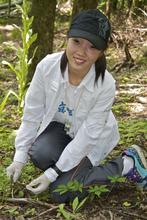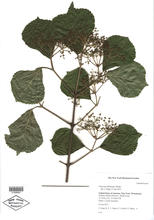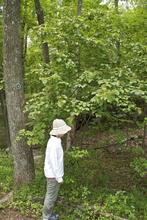By Camila Jingchen Jiang




The summer of 2013 will always sparkle in my mind. I worked as an intern at The New York Botanical Garden with Dr. Scott Mori and Dr. Robert Naczi, doing an inventory of the Zofnass Family Preserve in Westchester County, NY. During the ten-week internship, I became especially interested in the invasive plant species that have become established in the Preserve.
Invasive plants are alien to an area and disrupt ecological processes in the native habitats they invade. Although the Zofnass Family Preserve has a relatively small number of invasive plants, they should not be ignored because they can spread with dramatic speed. Due to their incredible adaptive ability and the fact that they create shade and therefore inhibit the growth of other plants, they can easily destroy the ecological balance of native habitats. In addition, invasive plants usually have efficient methods of seed dispersal and rarely have natural enemies in their new habitats. At excessive population levels, White-tailed Deer (a native species) threaten native plants in the Preserve because they consume native but seldom eat invasive plants. Consequently, populations of native species decrease while those of invasive species increase.
Hikers are one of the major dispersal agents of invasive plants into the Preserve so they should help to control their spread. The Westchester Land Trust (WLT) organizes volunteers to clean out invasive plants species by species and patch by patch. The WLT volunteers focus on relatively small but critical areas; for example at a trail head where a new population of an invasive has become established. In this way, it is possible for them to pull out most of the invasive plants in the chosen areas and efficiently stop invasive plants from encroaching further into the forest.
Many invasive species were first introduced from Europe or Asia as ornamentals; however, they often escape from private gardens and enter native habitats. As a result, homeowners surrounding the Preserve should avoid growing invasive plants in their gardens and landscapes. They should also consider cultivating native plants instead of potential invasive species from other parts of the world.
One of the worst invasive species that caught my attention during our inventory is the Japanese stilt grass (Microstegium vimineum) which penetrates the Preserve at the entrance to the Eastern Loop from where it has spread along the first part of the trail, and from there could get established in the interior of the forest. Fortunately, it is still possible to eradicate this pest simply by pulling it out. Otherwise, once it is established over a larger area it will difficult to control.
Another example is Viburnum dilatatum, an emerging invasive species presently occupying a relatively small area in Westchester County. This species is a cultivated alien species but based on our assessment it is scattered over 2.4 hectares (6.1 acres) in the Southern Loop area. Most of the plants are around 30 cm tall and are not reproductive, but we have also observed a considerable number of plants more than 2 m tall. These mature plants produce countless red fruits a year, and within five years, they will mature and produce large numbers of seeds. If the larger individuals are removed now, it is possible to keep this invasive from becoming another threat to the Preserve’s native flora.
Sometimes I feel disappointed to witness a plant with gorgeous flowers being considered invasive; thus, I understand why gardeners are eager to cultivate them. Nevertheless, I urge the Preserve’s neighbors to become familiar with potential invasive species and refrain from growing them. By mapping the invasive plants in the Preserve and organizing volunteer activities to remove them, the WLT is doing its best to protect the native species of the Zofnass Family Preserve.
Add new comment